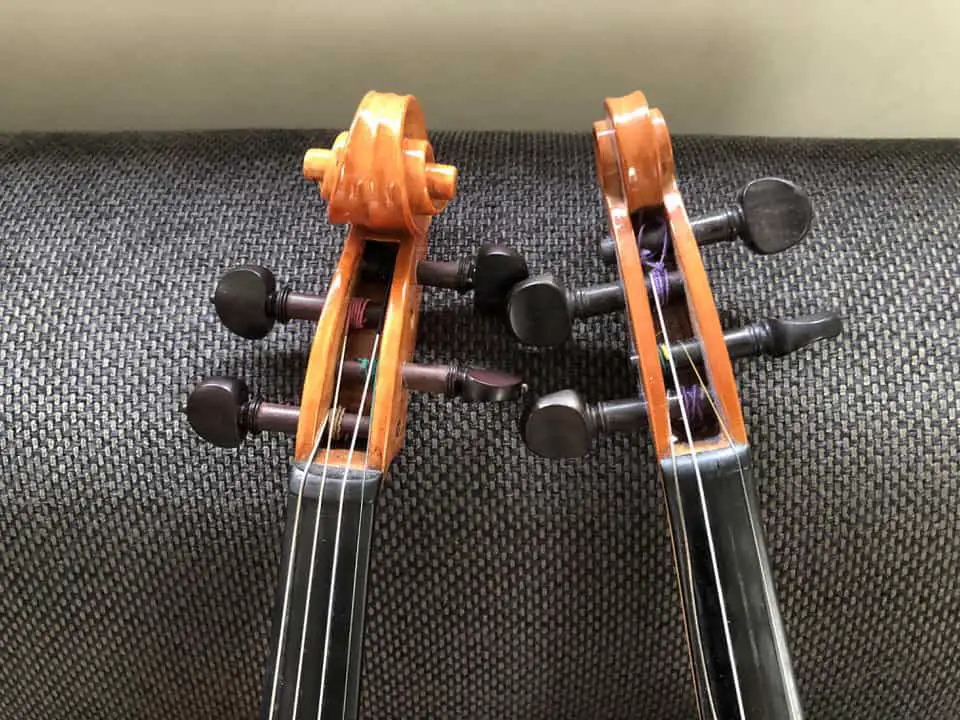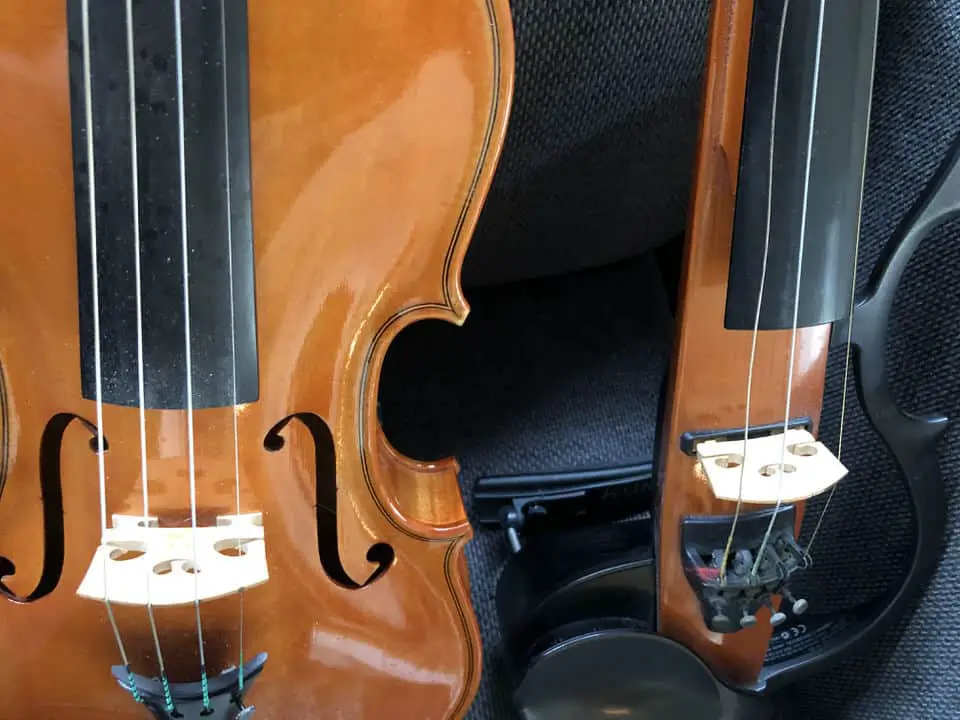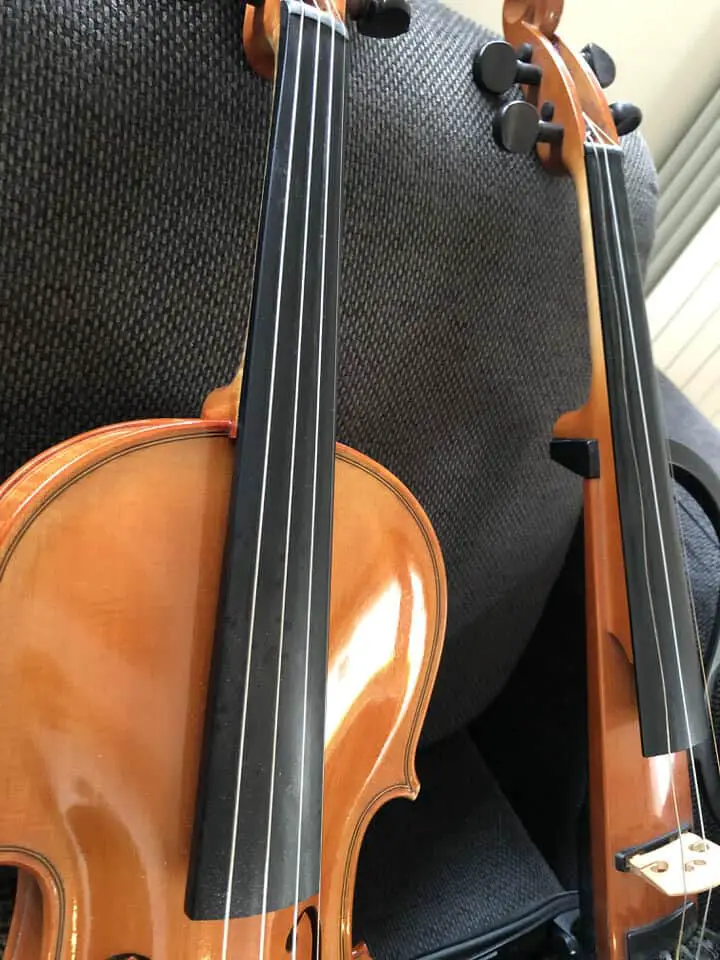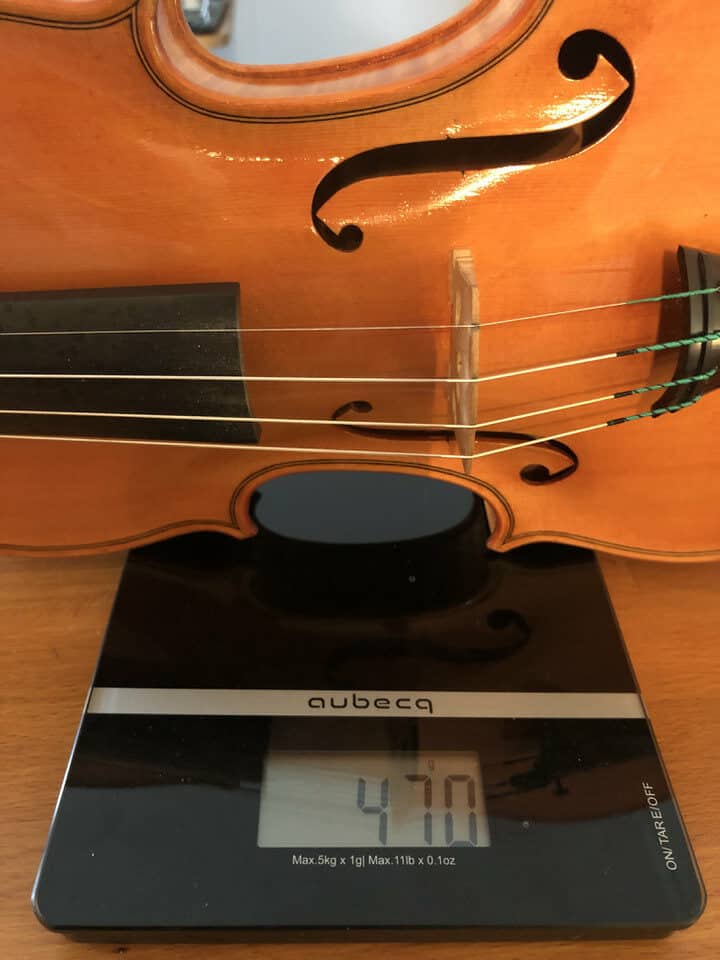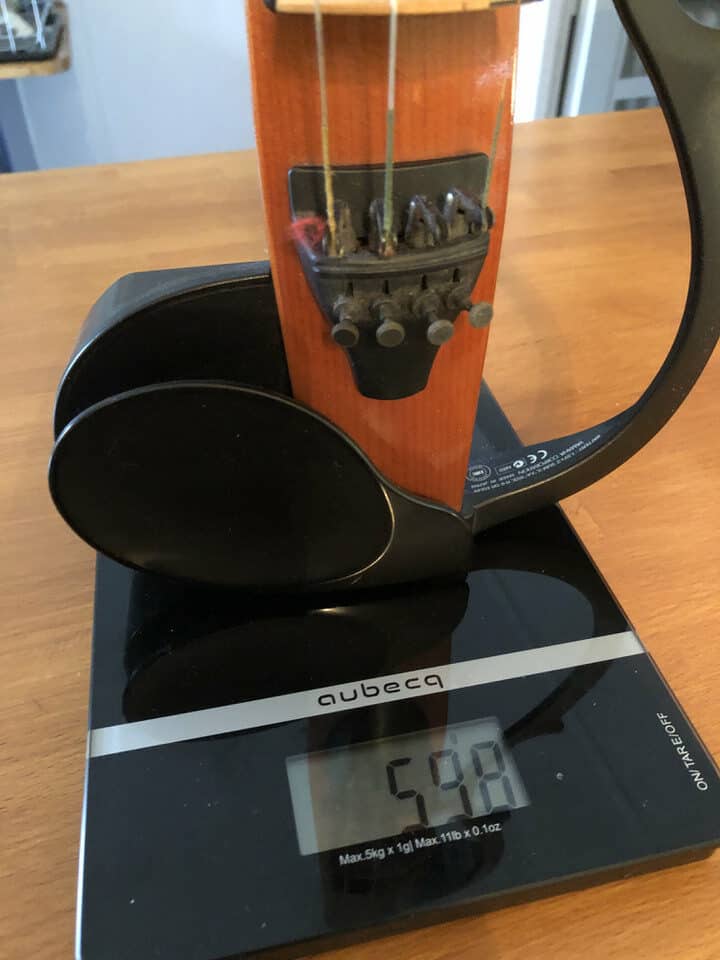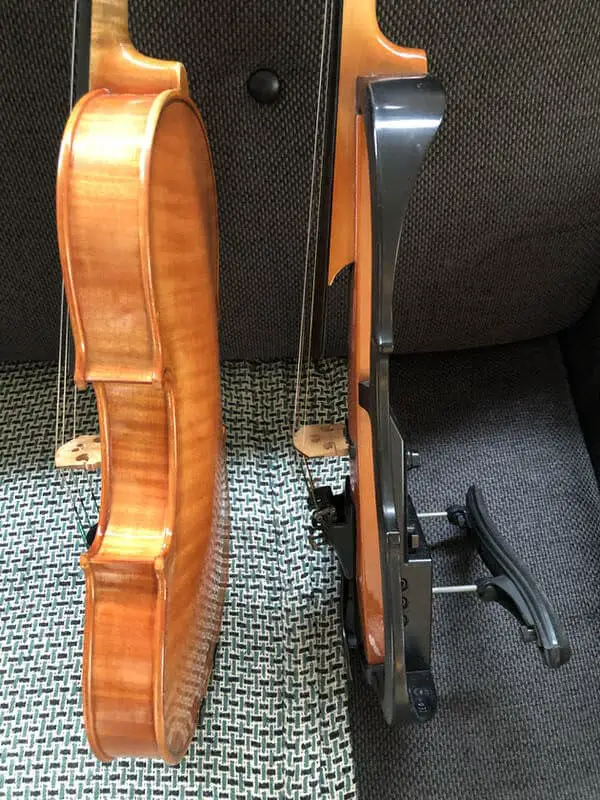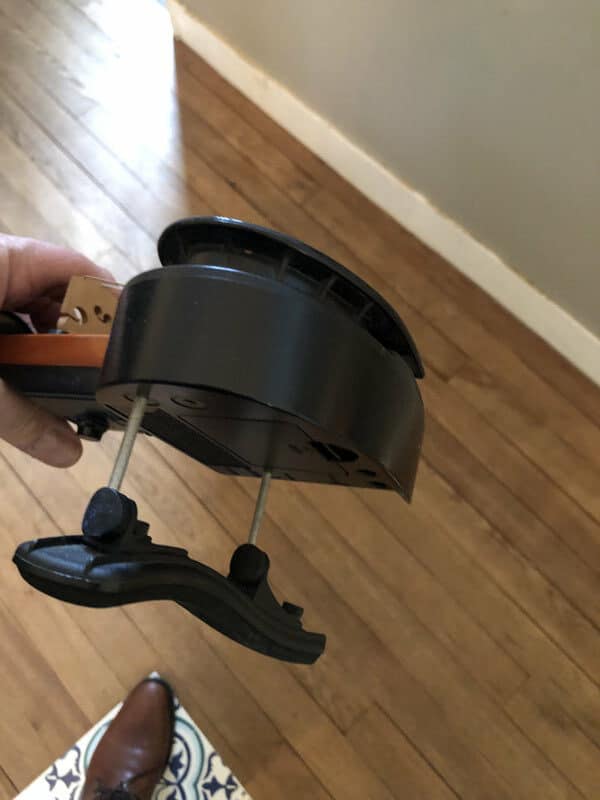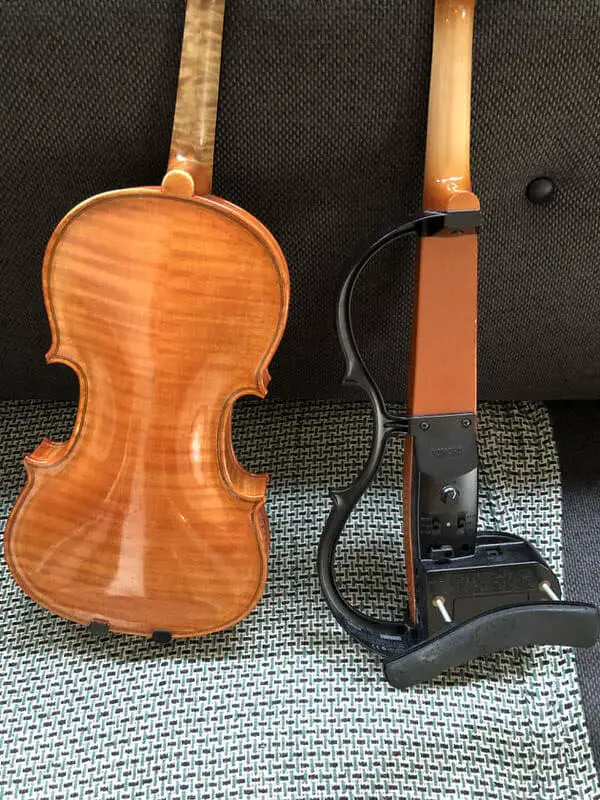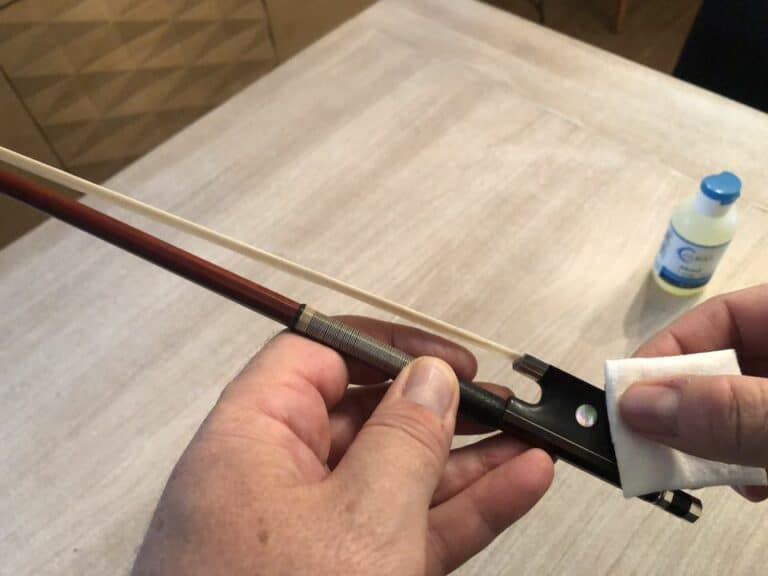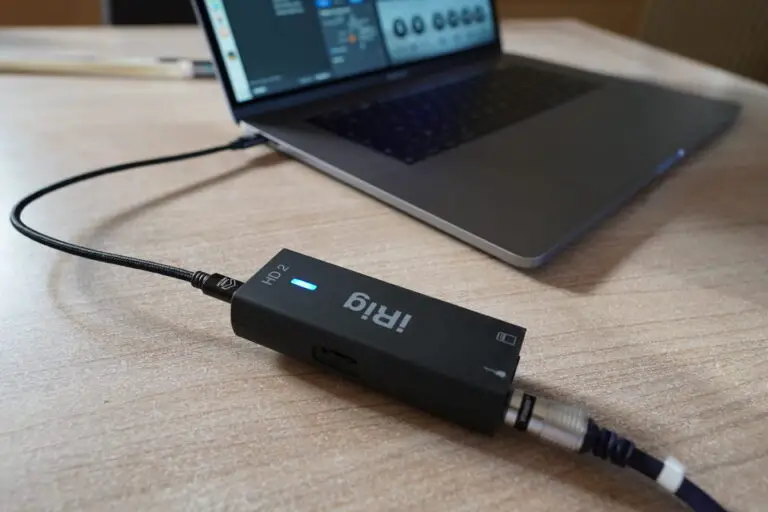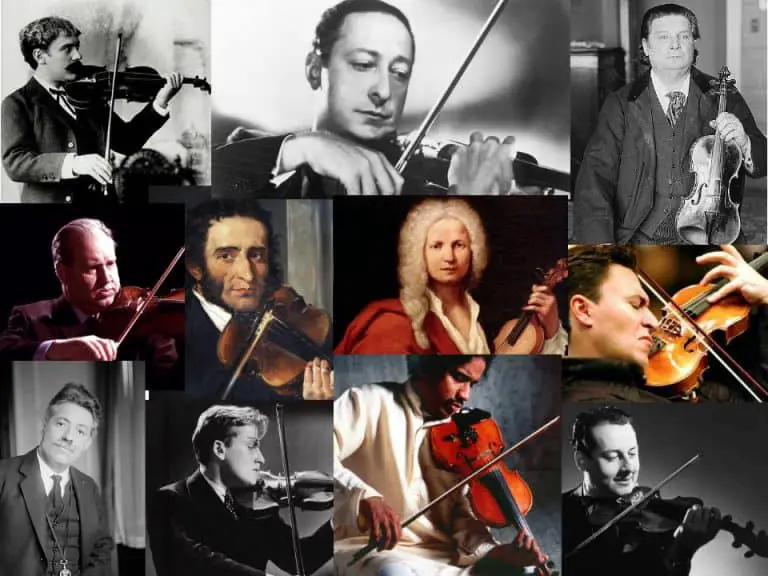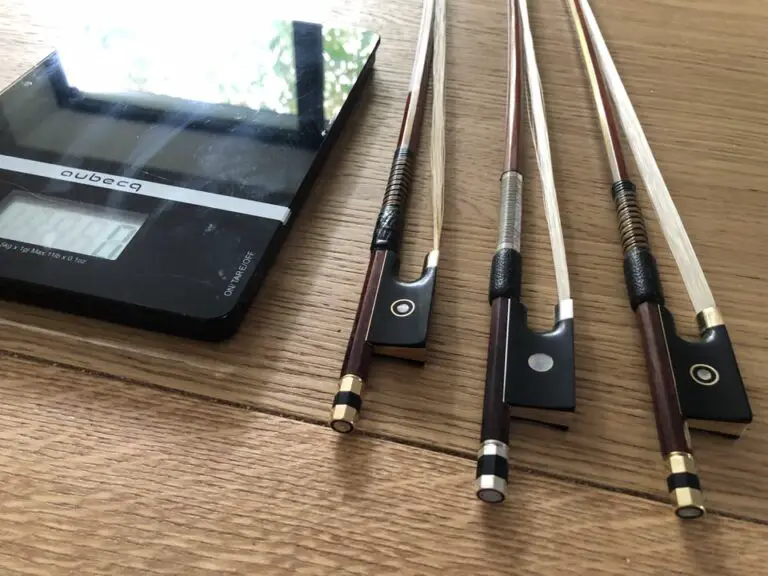Electric Violin vs Acoustic: a Comparison with Pictures
It doesn’t come directly to mind to buy an electric violin the first time we think about starting. The romantic aspect of violin playing usually involves an acoustic instrument, a Stradivarius.
But electric violins are not just for rock stars and not everybody can live in a big house without neighbors and practice at night. So what are the differences between an electric violin and an acoustic one that can make you prefer one over another?
Electric and acoustic violins have many things in common : the pegs, the fingerboard, the strings, the bridge. But their structure is different. The acoustic violin has a hollow structure while the electric one has a solid body. They both vibrate, but the acoustic violin has a natural acoustic tone production of a sound box. The sound of an electric violin is made by a piezo-electric pickup.
But the way the bow plays the string is different. So, can a violinist develop bad habits on an electric violin? There is a lot more to it, so read on to fully understand the pros and cons of an electric violin vs an acoustic one.
Electric violins are in many ways alike to acoustic violins
Electric violins are not that different from acoustic violins. They have 4 strings, a chin rest, and you can put a shoulder rest on them. There is a fingerboard of the same wood, length, and angle as on an acoustic violin.
There is usually a pegbox and the violin is tuned by turning the peg. But not always. The pegbox is the first part that can be missing on some electric violins. Their shape is more radical and modern.
So electric violins have usually 4 strings, and the bridge has the same radian to be able to cross strings, so nothing new there either. So the same bridge and the same kind of strings are used: you can put on an electric violin traditional acoustic violin strings. The only thing is that it is not may be worth buying the most expensive Pirastro gut Olive Strings, but otherwise, just choose the right gage and you’re all set. I usually prefer a lighter gauge on my electric violin and put less weight on the string while playing. But it is up to you to experiment with these. The electric violins I have played have always had a quick response.
An electric violin uses the same strings and the same bow as an acoustic violin.
The same type of bow is used to play an electric violin. There is no difference there either. And don’t consider playing with a carbon fiber bow just because your violin is electric if you plan to be able to switch back to your acoustic violin at a moment’s notice. You might not be able to play your spiccato and saltellato strokes just as well. If you use an electric violin to practice, the least thing you can do is to keep your preferred bow to still feel at home.
Globally, an electric violin has approximately the same size and weight as an acoustic one. If it differs, it is by a millimeter or two. Everything is made to have the violinist feel at home. The violin technique in general is such a fine and precise technique where grams and micro-millimeters count that everything is there to keep and maintain what is learned and mastered. You won’t lose your muscle memory and reflexes much. Most electric violins are designed to have violinist go back and forth between instruments.
Shape, structure and number of strings are different on an electric violin
1- Structure of the instrument
The acoustic violin has a hollow structure that vibrates and amplifies the sound, the electric violin has a solid body structure that vibrates (less). The sound needs a pickup to be amplified.
Therefore, the acoustic violin is lighter than the electric one.
At 470 grams (16.5 oz) the acoustic violin is noticeably lighter than the electric one (598 grams or 21 oz).
The main difference is how the sound is produced. Because an electric violin is designed to be plugged in, it doesn’t have a sounding board or box. A bit like an electric guitar. Electric guitars are solid body instruments, as invented by LesPaul. In the same manner, as the first Gibson was made, electric violins by Yamaha for instance are built around a wooden piece without hollow-sounding box. The sound is naturally soft and weak, almost silent. Yamaha has called its first electric violin « silent violin ». So it is a microphone that captures sound.
Without its traditional body, an electric violin can have different and new shapes, far away from the de facto Italian classical standard.
2- The shape of the instrument
But there is usually one thing important that is crucial to technique: the ability to rest the hand on the third position to the body as classical instruments provide. Yamaha has thoroughly measured and implemented that point of reference.
Some radical designs even remove the pegbox to look more modern. In that particular instance, the string is mounted the other way round. The ball is attached to the nut and the end of the string is secured and tuned to a micro adjuster close to the chin rest.
The thickness of the instrument is important. It has many consequences on how you hold your violin, thus how you play it.
Yamaha has improved in that respect. Their first violin was a bit too thin: I had to make a special chin rest to compensate the thickness or lack thereof.
3- Number of strings
Acoustic violins have 4 strings. Most of electric violins have 4 strings as well, but it is not uncommon to see electric violins mounted with 5 strings. The 5th string is a lower C, which gives the violin the possibility to go as low as a viola in the lower notes. That instrument has the range (tessitura) of a violin plus a viola, which can be quite interesting.
But playing with an instrument with 5 strings requires a different technic. It is not recommended to buy a 5 string violin unless you plan to adapt (alter) your technique to accommodate this new way of playing.
Well-known violinist, such as jazz violinist Jean-Luc Ponty usually, play with a 5 string electric violin. Indian classical violinist Subramaniam plays with a 5 string electro-acoustic violin.
Electric and acoustic violins have different tone production processes
1- Electric amplification vs natural soundbox
I have described and explained how the sound is produced on the violin in that lengthy blog post. It requires a perfect balance between the speed of the bow, the weight of the arm, the point of contact between the bow and the string. All that makes the bridge vibrate freely.
On the electric violin, on the other hand, there is a piezoelectric microphone under the bridge. It picks up the vibration of the string and translates it into electric information. The sound doesn’t involve the vibration of the wood at all, or as much. There is no sounding board, or soundbox if you will, per se, even if the main wood piece can vibrate.
2- Way to play with the bow on an electric violin
So the type of sound is different; if you want to get a good sound on an acoustic instrument, you need to practice for hours open strings and scales in order to get to the point where you can visualize in your head the perfect full sound you wish and actually be able to play it. There is no after-production.
On the electric violin, on the other hand, the tendency is to play without too much pressure, lightly. There is less squeaking sound, for a beginner. The sound is lighter, without edge. You can always adjust your amp to get the kind of equalization you want. You might be able to get the type of sound you want without actually playing it. Plus, you don’t need anymore to play in a church, a castle, or as many of us have done (myself included), in a bathroom to get a pleasing reverberation sound. That Bach in a church kind of feeling. Just press a button and add “reverb”: you’re there!
The type of sound is different, the tone production process is different. Someone who wants to have a classical career shouldn’t start and or play too much on an electric violin for that matter; he or she risks overlooking the most important part of violin playing which is tone.
Indeed, many rock and jazz violinists have an “over the string” airy sound, amplified with a big amp and effects. I went that route myself, without knowing it, day after day. My Russian Master was mad at me when he noticed that I have lost my tone skills. Now, I consider that jazz, blues, and rock are even more beautiful with that thick and full Oistrakh like tone. I tried to get that type of sound (I don’t compare myself with my Yamaha electric violin with Oistrakh and his Marsik Stradivarius, of course…) and amplify it afterward.
Alternately, I like to put a mike on my acoustic violin to get the best of both worlds.
So, if you play the electric violin AND still want to be able to play the acoustic violin well, you NEED to be fully aware of the difference in tone production.
Read on this article where I have detailed and compared electric and acoustic violins for their playability, and if it it worth starting off with an electric violin.
The gear and products I use and recommend for my electric violin
First, If you want to hear your electric violin, you need to either use headphones, plug it into an amp, or an audio interface.
The small amp I use and recommend if you want to practice at home is the great Yamaha THR10 from the THR series. It is portable and not expensive, easy to use and set up.
If you want to record yourself or plug your violin into headphones, your laptop, or your phone, a good and cheap digital audio interface I can recommend is the iRig HD2, which is more and more affordable on Amazon.
I typically use Thomastik Dominant strings on my electric violin. They come quite cheap on Amazon considering their quality and sound. Synthetic core strings work well on Yamaha electric violins.
Lastly, I use mainly Dominant rosin as well on my electric violin, as it has been designed to go with Dominant Strings.
You can check out in detail all the stuff I have tested and used on my recommended product page where I go into more details.

